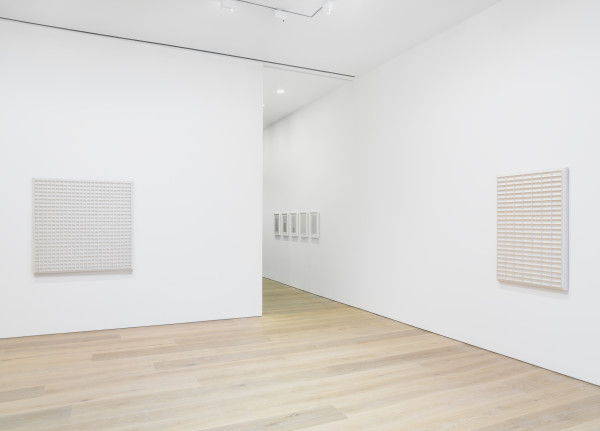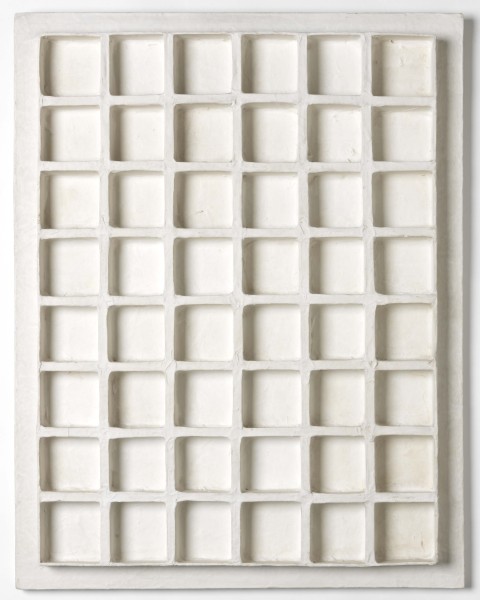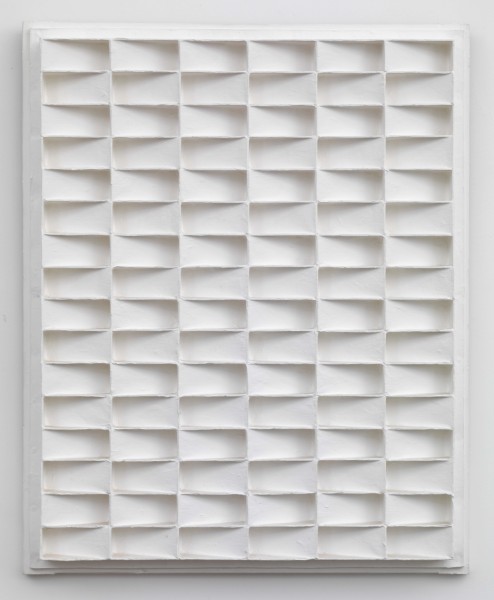Whitehot Magazine
May 2024
"The Best Art In The World"
"The Best Art In The World"
May 2024
Toward Grid-Light: The Art of Jan Schoonhoven by Robert C. Morgan
 Installation view, Jan Schoonhoven, David Zwirner, New York, 2015
Installation view, Jan Schoonhoven, David Zwirner, New York, 2015
© 2015 Jan J. Schoonhoven/Artists Rights Society (ARS), New York; courtesy of David Zwirner, New York/London
Toward Grid-Light
The Art of Jan Schoonhoven
David Zwirner (January 9 – February 14, 2015)
There are many angles by which to discuss the paintings of the extraordinary Dutch artist, Jan Schoonhoven (1914 – 1994) – angles that might elude those engaged in painting non-objective forms today. While viewers may grasp the purity of Schoonhoven’s relatively small paintings, based on constructed grids, as having a similitude with Mondrian, they might just as well discover a structural intimacy in Schoonhoven’s work that resembles works by some of the genre painters in seventeenth century Holland. At least one of the better-know artists from this period painted during off-hours while running an inn for travelers, which partially accounts for Vermeer’s relatively small, but precision output. For Schoonhoven, who worked as a civil servant in the municipality of Delft for most of his adult life, the situation was similar. He too painted on off-hours too, keeping a regular schedule on a diurnal basis that commenced upon the completion of a day’s work at the post office.
As far as we know, Schoonhoven lived a relatively simple life. He maintained relatively small, yet adequate quarters. This was where he ate regular meals, slept, and did his work. We know that he was introduced to the Italian achrome artist, Piero Manzoni, at a strategic point in the Dutch artist’s career, which would have been around 1959-60. Manzoni, who for a short time exhibited with the Zero group in Dusseldorf, was favorably disposed to the molded paper paintings of Schoonhoven. Eventually the molded paper works moved into a series of works using corrugated paper and eventually into the grid structure for which he later became known.
In the grid-paintings that emerged in the first half of the 1970s, a luminescent quality appears in the all-over whiteness of Schoonhoven’s surfaces as the scale of these works gradually increased in size. A selection can be seen on the north side of the gallery to the right of the stairway on the second floor at David Zwirner on West 20th Street. The quality of these works in which paper is discretely mounted over a perpendicular grid, and then painted, becomes ineluctably apparent. The chronology begins on the southwest side of the gallery where it is best to begin viewing the exhibition in order to experience the development of the artist’s central idea.
 Installation view, Jan Schoonhoven, David Zwirner, New York, 2015
Installation view, Jan Schoonhoven, David Zwirner, New York, 2015
© 2015 Jan J. Schoonhoven/Artists Rights Society (ARS), New York; courtesy of David Zwirner, New York/London
In general, Schoonhoven’s works suggests a quality of invisibility and intimacy in painting, perhaps better understood by artists and scholars in East Asia than by those in New York. For example, it became excruciatingly clear to me that the conventional concept of installation photographs of these work in situ had no meaning. One could see the interior architecture of the gallery, but not the works themselves. These works require a way of seeing closer to the manner in which we might view works by paper by Paul Klee or etchings by Rembrandt. In either case, the work is so refreshingly intimate that one may feel a special repose in looking at them. How to explain this? There is no a prioi text available to explain this (as far as I know). These works insist on the experience of seeing. There is no separation between the object as art and the experience of aesthetic. They are so perfectly entwined in Schoonhoven’s work.
These paintings are invisible by contemporary standards, that is, at a time when virtual economics is replacing haptic (sensory) experience. These paintings are invisible because there is really nothing, or very little, to see. There is no image to shock our senses into retreat. Yet at the same time, Schoonhoven allows us to see everything in his paintings. Ruminating on what it is like to stare upward on a clear cold winter night, these works are bright and luminous – and as empty as the universe.
Il est temps (as the French say), or “it takes time.” It would seem that Schoonhoven’s way of seeing was paradoxically embedded in a knowledge of the past and the history of the present. The memory that emerges from what the retina beholds – what Aldous Huxley once called “the windows to the brain “ – includes the neurons and electrons, which are fully prepared to come to terms with this kind of seeing/experience. Perhaps, Schoonhoven was a visionary artist less in terms of theory than through the kind of poetics that helps us remember to remember. His work offers a means for us know who we were and what we might still become at a time when the necessary to re-evoke this quality may mean the basis of our survival. WM

Jan Schoonhoven, 48 Squares, 1965, Painted papier-mâché on wood, 20 15/16 x 16 3/8 x 1 5/8 inches
53.2 x 41.6 x 4.1 cm © 2015 Jan J. Schoonhoven/Artists Rights Society (ARS),
New York; courtesy of David Zwirner, New York/London

Jan Schoonhoven, Rechthoekig Relief, Schuine Binnenvlakken, 1966, Wood, cardboard, paper, and emulsion paint
31 1/2 x 25 9/16 x 2 3/4 inches, 80 x 65 x 7 cm © 2015 Jan J. Schoonhoven/Artists Rights Society
(ARS), New York; courtesy of David Zwirner, New York/London

Robert C. Morgan
Robert C. Morgan is an educator, art historian, critic, poet, and artist. Knowledgeable in the history and aesthetics of both Western and Asian art, Morgan has lectured widely, written hundreds of critical essays (translated into twenty languages), published monographs and books, and curated numerous exhibitions. He has written reviews for Art in America, Arts, Art News, Art Press(Paris), Sculpture Magazine, The Brooklyn Rail, and Hyperallergic. His catalog essays have been published by Gagosian, Pace, Sperone Westwater, Van Doren Waxter, White Cube (London), Kukje (Seoul), Malingue (Hong Kong), and Ink Studio (Beijing). Since 2010, he has been New York Editor for Asian Art News and World Sculpture News, both published in Hong Kong. He teaches in the Graduate Fine Arts Program at Pratt Institute as an Adjunct Professor and at the School of Visual Arts.
view all articles from this author








